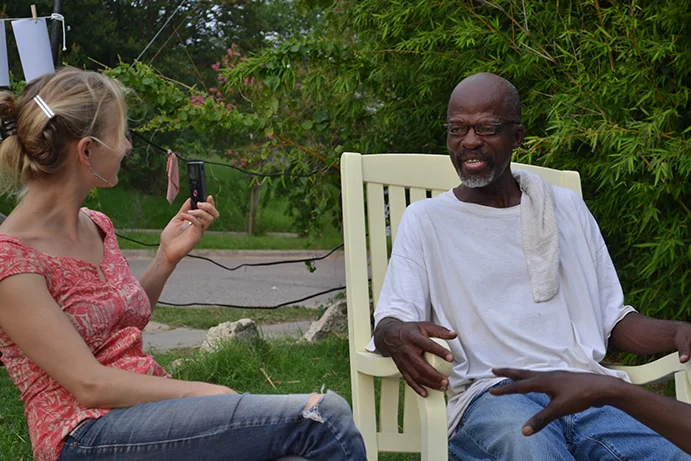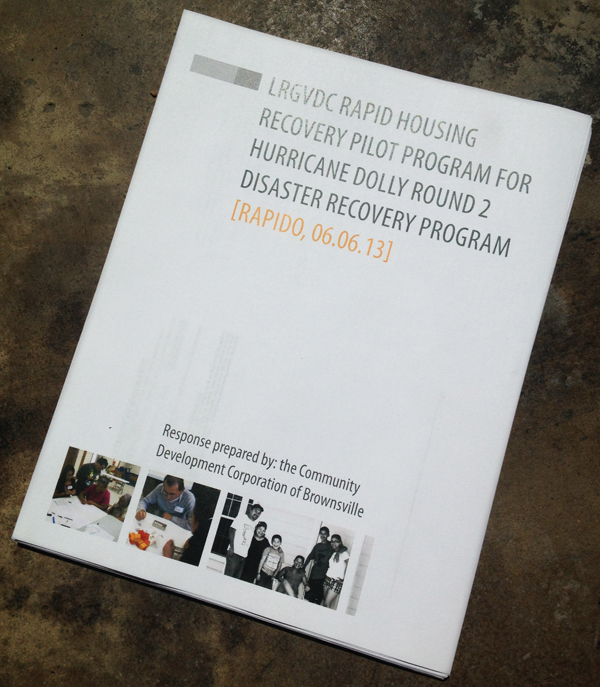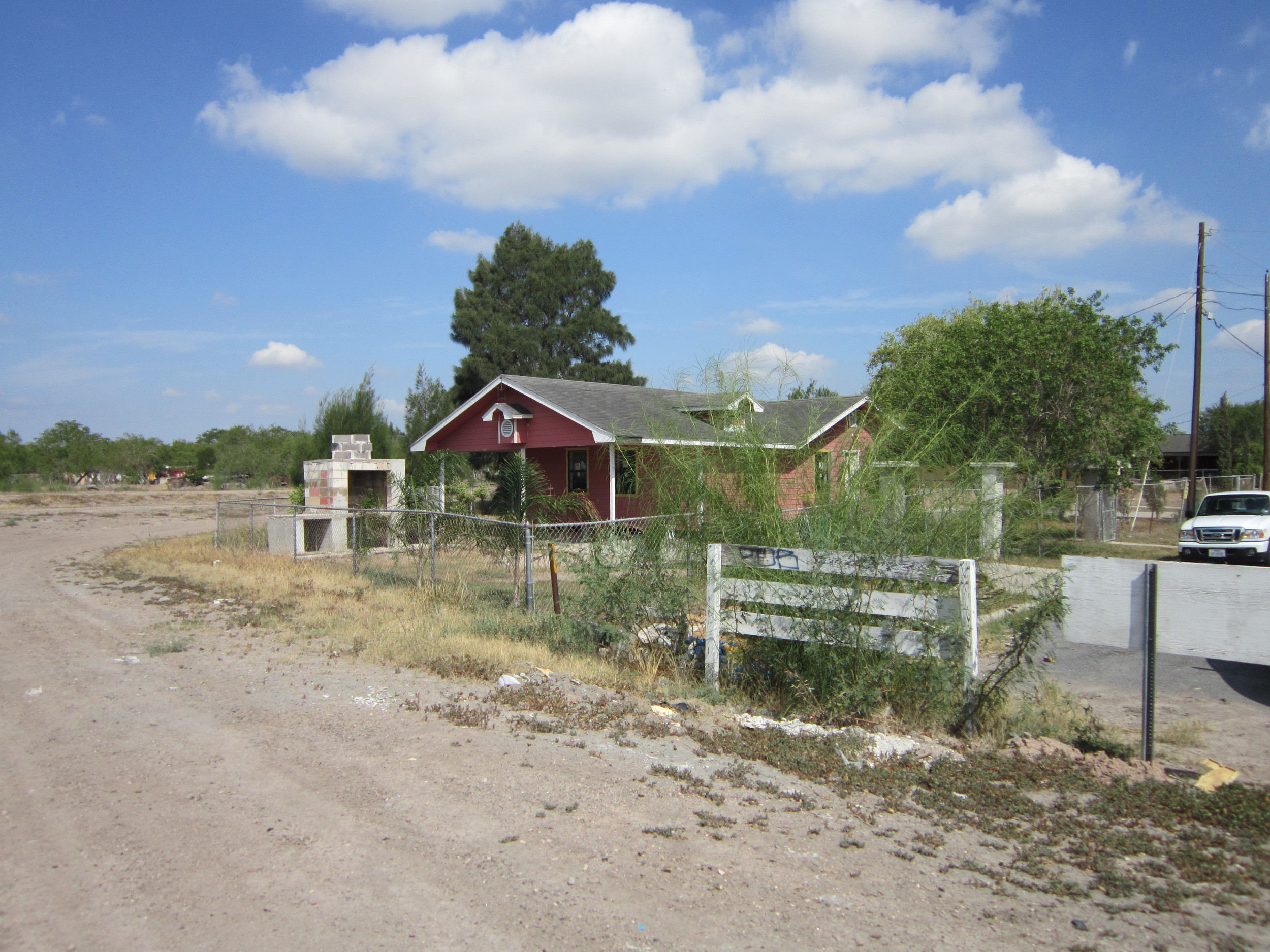New sAh Underway
Read about other sustainABLEhouse projects.
Construction drawings have been completed for the first client-driven sustainABLEhouse in Dallas. The client, an 81 year old resident of the Frazier and Bertrand neighborhoods, was brought to the bcWORKSHOP through a partnership with Frazier Revitalization Inc. FRI enlisted bcW to provide the engagement + design services for the new 750 sf home and its wooded site just blocks from the client's existing home of 29 years.
Engagement + design occurred onsite and at the client's current home over a three week period in July 2013. The client responded very well to the design process, eagerly filling out the initial homework assignment following the first meeting, to help bcW understand his family structure, how he uses his current home, and any specific needs that the forthcoming design could help address. In subsequent design meetings, the client was whole-heartedly engaged and his growing excitement was clear. Throughout the process, the client was very attentive to considerations such as durability, maintenance, functionality, and budget. After participating in the design process, the resulting home design will be one that is most suited for the client's personal and family needs.
Over the course of the month, a design was developed that reflects the client's family-focused life and love for his wooded site. The home will sit gently on the site behind an enormous pecan tree and among a mixture of a dozen established bois d'arc and hackberry trees. A small open porch at the front of the home will greet the street, originally designed at the client's request to host his frequent domino matches. Since design has begun, however, this porch has shifted to become the "card porch" as client's gaming taste has changed (according to the doctor, playing dominoes gives him high blood pressure). The "L" shaped home will wrap around a fenced backyard where the client's grandchildren will be able to safely play away from the street, while additional family members gather in the wide open living, dining, and kitchen space.
Bidding for the construction of the home will now ensue and construction will follow. The goal is to have the client in his new home by the end of the year.
Mount Auburn Stories
Read more about Neighborhood Stories and POP Dallas.
On Saturday, August 17th Neighborhood Stories celebrated the community of Mount Auburn. Since the start of its development in 1907, Mount Auburn has remained a stronghold for East Dallas’ working class residents who have consistently campaigned for the retention and betterment of single-family homes, streets, and parks. Culturally and economically diverse, Mount Auburn’s population has gradually shifted from predominantly Anglo to predominantly Latino. This shift has brought change to the historic neighborhood, with renovated homes and businesses expressing the culture of its current residents. Not immune to inner city problems, the neighborhood has rebounded from the city’s suburban migration in the 1960s and the subsequent increase in crime in order to emerge as a stable, active neighborhood. Though not a historic or conservation district itself, Mount Auburn has certainly benefitted from city ordinances that protect the character of the surrounding areas; however, its success can mainly be attributed to its residents. The strong advocates of years past established, protected, and improved the parks, schools, and quiet connectivity that lend Mount Auburn the peaceful vibrancy it enjoys today.
As part of the Neighborhood Stories series, activities included a bike/walk paseo through the neighborhood, exploring exhibit stations that showcase the physical and social history of Mount Auburn; a community meal with food from local residents; and a sunset screening of the neighborhood film.
Announcing Activating Vacancy
Check out future Activating Vacancy posts here.
Activating Vacancy will explore how design and art can re-imagine the forgotten or neglected spaces in the Tenth Street community as part of a dialogue about what the neighborhood is, was, and could be. Up to six collaborators will be commissioned by bcWORKSHOP to immerse themselves in the community, working with residents and stakeholders to develop and execute six projects. Together, these works will challenge common public perceptions of vacancy in Tenth Street and critically consider historic preservation, among other urban conditions, as they relate to the neighborhood.
Diverse artistic media will be applied throughout Tenth Street, exploring sites and issues critical to the neighborhood’s past and future. Through creative interpretation, Activating Vacancy will enable both community members and the larger city to rediscover this culturally and historically significant place. Artists, designers, and arts educators are encouraged to respond to an open Call for Collaboration and submit qualifications to be a part of Activating Vacancy.
Recognized by both the National Register of Historic Places and the City of Dallas Landmark Districts, Tenth Street was founded as a freedman’s town shortly after the Civil War. As a result of segregation, the neighborhood was driven to self-sufficiency, and African-American businesses, churches, and families thrived. When integration opened opportunities in newer suburban areas and South R.L. Thornton Freeway (I-35E) was forced through the heart of the area, the aging Tenth Street neighborhood began to decline. Today, it is both one of Dallas’s oldest and most culturally significant neighborhoods, and one whose history is at greatest risk.
The Initiative begins Fall 2013 and is produced and curated by bcWORKSHOP, a Dallas-based community design center, in partnership with the Dallas CityDesign Studio who will be developing a policy framework and guide for future development for the historic district. Based on this partnership, Activating Vacancy will be part of a unique environment where art can influence, not respond to, policy creation.
Activating Vacancy is made possible through generous funding by the National Endowment for the Arts, the Trinity Trust Foundation, the Dorothea L. Leonhardt Foundaiton and local arts patrons.
Design Sketches
Read more from our Shopfront series.
July 25, 2013: Design Sketches
Reception begins at 5:00 PM, with talks at 5:30. Please RSVP.
Speakers will offer short talks about their work, how it intersects with design, and what they believe is essential to make Dallas a healthier, more vibrant, livable city for all. Confirmed speakers: Ann Bagley, Rob Colburn, Bang Dang, Wanda Dye, Omar Hakeem, Anna Hill, Tipton Housewright, Christa McCall, Cynthia Mulcahy, and David Preziosi.
Presentation themes: What is the true value of preservation in revitalizing communities? How can public art serve as a mirror and amplifier of community identity? When are physical design solutions needed to meet social needs? How can grassroots organizing booster the work of local governments?
Visibly Making an Impact
Learn more about sustainABLEhouse in the RGV.
Still in its first year, sustainABLEhouse LRGV, in partnership with Community Development Corporation of Brownsville (CDCB), has worked with 23 families (totalling 64 people) from 17 different neighborhoods throughout Cameron County. Each family is an integral part of the design process, helping to guide design decisions beginning with the layout of their house and ending with the selection of colors and finishes.
Seven homes are currently under construction, ranging from foundation preparation to final energy efficiency inspection. Two more homes are scheduled to begin construction by the end of July with a steady stream of construction start dates to follow. bcWORKSHOP staff in both the Dallas and Brownsville offices have been working on this effort. We share the responsibilities of design, design reviews, construction drawings, and refinement of program goals and practices. Client meetings and construction administration are carried out by the Brownsville office.
Our design process is initiated by the clients. They elect to work with us by agreeing to complete a brief homework assignment before we sit down to focus on design. The homework is a booklet of questions asking the client such things as general family information, how they use space inside and outside their home, and specific needs that the design can help address. The design process varies depending on if the client chooses a catalog home design or the custom design process.
After our design process and after bcWORKSHOP has completed the construction drawings, we meet with the client and the contractor to discuss the goals of the design, the construction drawings, and the construction process. Once construction begins, bcWORKSHOP regularly visits each home with CDCB’s construction manager. Together we look over the work with the contractor and address any issues. In addition to checking progress, construction visits are an opportunity to document and share how a house comes together. Photos from these construction visits serve as a communication tool for our clients on how their home is constructed and as a teaching and learning tool within bcWORKSHOP.
The immediate goals for sustainABLEhouse LRGV are to continue expanding and evolving our home design catalog, assist CDCB in their outreach strategies, and help more families throughout the Lower Rio Grande Valley.
Dallas City Grid(s)
Learn more about our Shopfront series.
Every new bcFELLOW arriving at buildingcommunityWORKSHOP receives a small research assignment. It serves partially as an introduction to bcWORKSHOP, and partially as an introduction to the city of Dallas. Most FELLOWs study the development of a single neighborhood, often one with some other link to the work of our office. But instead of studying one neighborhood, my assignment was to study the entire Dallas street grid. Not really a small research assignment. Did I mention I had never even been to Dallas before joining bcWORKSHOP?
Whenever I told anyone I was studying the Dallas street grid I always received the exact same two-word response. “What grid?”, he would reply, half joking, half serious. And it’s true. Dallas does not have the nice clean street layout like Manhattan, or even Washington D.C. (which makes a lot more sense from the air then when you actually have to navigate through it). Heck, even Los Angeles, where I had been living, had nice numbered streets and something resembling order. In Dallas, I have taken the wrong street many times. Or a street has taken a bend and gone a completely different direction than the one I was intending to travel. And I still have not figured out how that Exposition Avenue intersection works, even after this project.
However, it was my job to make sense of this mess. And the truth is, if you break it down and look at the individual pieces, it is really not all that complicated. Every street was laid out by some (reasonably) rational individual, even if that reason is no longer obvious. With a few exceptions, most streets follow one of three grids, each older than the city itself:
- A grid at 45 degrees to the cardinal directions, laid out by a man named Warren Ferris for settler John Grigsby. This covers areas like Old East Dallas, Oak Lawn and South Dallas.
- A grid aligned to the cardinal directions laid out under businessman W.J. Peters for the Peter’s Colony venture, which covers a portion of North Texas about the size of the state of Maryland. This is all the large square sections as you move away from the center of Dallas to the north and into Oak Cliff.
- The grid laid out by John Neely Bryan aligned with the Trinity River. That is the streets like Commerce, Main and Elm, that spread northeast through downtown into Deep Ellum.
Throw in about a dozen railroads, competing real estate interests (a surprising number of which were settled in the Supreme Court of Texas), the Trinity River, and a gaggle of freeways, you end up with the street layout Dallas has today.
The streets of Dallas account for a huge portion of our city, both in terms of the physical land and the way we experience our city. So instead of resigning ourselves to jokingly asking “What grid?”, let’s see if we can gain something by actually discovering what is going on.
Public Design in the Crescent City
Read more about our Shopfront series.
June 20, 2013: Public Design in the Crescent City
Maurice Cox is an urban designer, architectural educator and civic leader. Cox serves as the Associate Dean for Community Engagement at Tulane University, School of Architecture and Director of the Tulane City Center where he oversees a wide range of initiatives with Tulane architecture faculty and students throughout the New Orleans community. He joined the faculty of Tulane from the University of Virginia where he was an Associate Professor of Architecture, and served as mayor of the city of Charlottesville, Virginia from 2002-2004. Cox also served as Design Director of the National Endowment for the Arts from 2007-2010. In that capacity, he led the NEA’s Your Town Rural Institute, the Governor’s Institute on Community Design, the Mayors’ Institute on City Design, and oversaw direct design grants to the design community across the United States.
Over his 17-year career at the UVA, Cox merged architecture, politics and design education to define a new role for the designer—that of civic leader. Nationally respected for his ability to incorporate active citizen participation into the design process while achieving the highest quality of design excellence, Fast Company business magazine named him one of America’s "20 Masters of Design" in recognition of his practice of "democratic design." A founding partner of RBGC Architecture, Research and Urbanism from 1996-2006 the firm was acclaimed for its partnerships with communities traditionally underserved by architecture. Their design for a New Rural Village in Bayview, Virginia received numerous national design awards as well as being featured on CBS’s "60 Minutes" and in the documentary film "This Black Soil". A recipient of the 2009 Edmund Bacon Prize, the Harvard University Graduate School of Design 2004-05 Loeb Fellowship and the 2006 John Hejduk Award for Architecture, Cox received his architectural education from the Cooper Union School of Architecture.
At Tulane, in addition to directing the Tulane City Center, Cox works with the highly successful programs of URBANbuild, the Tulane Regional Urban Design Center, the preservation program and the school’s new Master of Sustainable Real Estate Development program, all which are community outreach design initiatives of the university.
Tenth Street Stories
Read more about Neighborhood Stories and POP Dallas.
On Saturday evening, June 15th, the bcWORKSHOP team got together with the Tenth Street community for the fourth Neighborhood Stories event. We partnered with two churches founded in the neighborhood, Greater El Bethel Missionary Baptist and Elizabeth Chapel CME Church, for a choir performance. Neighbors and visitors enjoyed a potluck BBQ dinner, followed by a sunset screening of a film featuring interviews with current and former residents and those who have been involved with the neighborhood over the years. A gallery exhibit and booklet communicated Tenth Street's rich history and strong culture through photos and maps. Approximately 150 people attended the event, sharing their memories and dreams for the neighborhood on an interactive map and a rope line that stretched across the site.
CDCB Construction Standards
Learn more about our work in the RGV.
bcWORKSHOP is developing residential construction standards for the Community Development Corporation of Brownsville (CDCB) in partnership with CDCB’s team of advisors. Residential construction standards are a customized set of best practices intended to regulate and elevate construction quality, improving the overall quality of life for their clients. Construction standards will ensure that CDCB residential projects are planned, designed, and constructed to promote sustainable development and best practices for the Lower Rio Grande Valley. These standards will create continuity and equity between products and will standardize process, policies, and procedures.
In order to achieve the above goals, construction standards will incorporate recommendations from local and national performance standards that address healthy, affordable, constructible, low-tech, sustainable building practices appropriate for South Texas and CDCB. Currently, all projects built under these guidelines will qualify for:
- ENERGY STAR 3.0
- Indoor airPLUS of the Environmental Protection Agency
- LRGV Low Impact Development
- RGV Green Built
Construction standards will be complete and ready for implementation by the end of summer 2013.
Tenth Street Stories Film
Learn more about Neighborhood Stories and POP Dallas.
Rapido 2.0
Learn more about Rapido.
On June 6th 2013, bcWORKSHOP submitted a response to the LRGVDC Rapid Housing Recovery Pilot Program (RHRPP) RFP as part of a team including the Community Development Corporation of Brownsville (CDCB) and Austin Community Design and Development Center (ACDDC). Building off of previous research, community engagement activities, design work, and a prototype home completed in 2012, the team - comprised of both local stakeholders and national experts - will complete the following:
- Design of a locally informed and driven Rapid Housing Recovery Pilot Program to be used throughout the State of Texas as described in HB2450.
- Demonstrate and test the feasibility of implementing a plan for the large-scale production of replacement housing for survivors of federally declared natural disasters through the construction of twenty prototype homes in Cameron, Hidalgo, and Willacy counties.
- Provide analysis based on RHRPP system monitoring that indicates program successes, challenges, and recommendations for improvements that will inform the GLO’s disaster housing delivery plan statewide.
If selected, the team is expected to receive a contract at the end of June and will immediately begin process and policy design work. It is anticipated that the construction of all twenty prototype homes and program reporting will be completed by November of 2014.
RGV Affordable Housing
Learn more about our work in the RGV.
A family's income defines its available choices in housing. In the Lower Rio Grande Valley (LRGV) of Texas, very low-income families have little to no choice available to them. The predominant type of very low-income housing is substandard, isolated from public institutions, and often negatively impacted by stormwater. These isolated communities do not fall within municipalities, and it is up to the counties to adopt Subdivision Regulations that may require a minimum quality of housing development. Counties currently spend their planning capital on bringing public infrastructure to new and existing neighborhoods located in such isolation. This causes counties to continuously search for outside funding to address these critical issues.
bcWORKSHOP Planning Associate Justin Tirsun has been leading an effort to catalogue all existing Federal, State of Texas, Hidalgo County, Cameron County, and local plans that address critical issues in substandard developments both directly or indirectly in the Lower Rio Grande Valley. The recommendations put forth in these plans are categorized by issue, and analyzed on the following criteria:
- Do the recommendations act in contradiction to or work in support of existing plans?
- Is there the potential for alignment between planning goals and measures of success between multiple agencies?
- Is the issue one that would have been rectified if zoning required the subdivision in an non-isolated region of the county?
The resulting catalogue is organized by the issues that have been identified by the state, counties, cities and local organizations that contribute to the cost of affordable housing:
- Available Quality Housing
- Poor Development Patterns
- Access to Potable Water
- Access to Sufficient Sewer Infrastructure
- Adequate Drainage and Stormwater Management
- Access to Transit
- Access to Healthcare Institutions
- Access to Education
- Access to Jobs
The catalogued planning efforts affect a population of more than 100,000 residents in Hidalgo and Cameron counties. The catalogue will serve as a regional resource providing LRGV agencies and the public a single library of all plans that affect quality of life issues. It will be a single source for policy implementation addressing critical issues of housing, and how collaboration should occur between agencies when working on affordable housing choices. Finally, it will address an argument that providing the counties with zoning capacities will alleviate much of the same quality of life issues in future county development.
The catalogue will be shared with stakeholders on June 24, 2013.
SMU deploys POP Toolkit
Learn more about POP Dallas.
In February 2013, Southern Methodist University’s Innovation Gymnasium and bcWORKSHOP began talks about a partnership to bring engineering students into neighborhoods to develop socially engaged technology solutions. The Innovation Gymnasium regularly runs Immersion Design Experiences (IDEs), intensive ten-day interdisciplinary engineering design projects for real clients that allow students to build skills with client relations, research, prototyping, finance, and marketing. During the last week of May 2013, the IDE began work within Dolphin Heights. Seven engineering students were presented with an unwieldy problem: how can you measure healthy living environment, connectivity, and cohesion, three of the Measures contained in the POP Toolkit? They brainstormed a number of possible solutions including: a wireless sensor network that could detect noise, light, weather, and air quality and relay the information to a website to host and display collected data; an interactive Neighborhood Board to display sensor-gathered data and also collect qualitative data; and a Wi-Fi bench to serve as a gathering place for the community while providing Wi-Fi to the neighborhood. Due to the budget and time constraints, the students decided to focus on producing the wireless sensor network and the website to display the collected data.
By tracking levels of sound intensity at sensors scattered throughout the neighborhood, students hypothesized that they could map movement and pinpoint circulation patterns (connectivity), gathering places (cohesion), as well as ambient noise (healthy living environment). Tracking light with photosensors at night and during the day would identify light pollution and available shade, two more components of a healthy living environment. An additional single sensor recording weather and air quality would help understand pollution (healthy living environment).
The students did a commendable job working hard under pressure with a great deal of sensitivity to the neighborhood’s interests and perceptions. Their technical success compares with their enthusiasm to extend their short-term solution into a long-term project complementing the POP Toolkit’s mission: assisting grassroots planning by preparing the community as advocates for change.
Many thanks to engineering students Kate, Greg, Elizabeth, Eric, Jeff, Lauren, Matt, Austin, and Alex! We are already looking forward to future collaboration!
Academic Influences Panel
Read more from our Shopfront series.
June 7, 2013: Opening Reception and Panel
On Friday, June 7th, bcWORKSHOP hosted a panel on the relationship between academic institutions, professional design practices, and the national public design movement. The panel was moderated by bcWORKSHOP's Associate Director Benje Feehan, and included Yasenia Blandon, the co-founder of Latinos in Architecture and Associate at Perkins + Will, Danny Samuels of the Rice Building Workshop, and Don Gatzke, Dean of the School of Architecture at the University of Texas at Arlington.
POP Measures & Tools
Learn more about POP Dallas.
The last POP Toolkit post, in March, mentioned we were looking for a neighborhood to partner with us to Pilot the Toolkit. We found that partner in the Mill City neighborhood, but what has happened in the meantime? Making that announcement revealed to us how much more work still needed to be done -- refining our product and engagement, yes, but also our project definitions.
We had figured out what the Toolkit was and how it worked, but not how to explain it. Our (self-described) “fun and engaging process” was clumsy and awkward to explain or facilitate. We had to go back to the drawing board, where we had long ago stated that the POP Toolkit would structure, visualize, and organize grassroots planning. These principles neatly organize the pieces and parts that make up the Toolkit Process.
The Toolkit structures change by challenging stakeholders to declare a scale of intervention, whether it be the house, the street, the neighborhood or the city. This identifies expectations, a potential audience, and stakeholders.
Livability Measures and Engagement Tools
The Toolkit visualizes change by establishing baseline conditions, contributing factors, and possible solutions to neighborhood concerns. These neighborhood concerns helped us filter global livability research into eight Measures of Livability. The Measures are Density, Form, Use vs. Entitlement, Ownership, Healthy Living Environment, Connectivity, Safety and Cohesion.
Finally, the Toolkit organizes change through twelve Engagement Tools: strategies to convert everyday activities into activism. These are split into three Methods which provide a flexible guide to planning Workshops. The Walk, Meter, List or Web lend themselves to discovering Connections. The Messenger, Gallery, Performance or Meeting are good strategies to share those discoveries. The Act, Garden, Dinner and Plan make a difference. All of the Tools should be used with reflection to deepen the impact and understanding of each step.
The POP Toolkit is, at it's simplest, a way to deploy design thinking as a community organizing Tool. It reflects the process we at bcWORKSHOP use in all our design and making, and puts those skills in neighbor's hands to expand the impact we can make together.
Public Design by Texas Students
Check out more from our Shopfront series.
Texas Design Schools: Exhibiting Public Interest Projects
bcSHOPFRONT is pleased to announce its summer 2013 series of programming anchored by the exhibit, Texas Design Schools: Exhibiting Public Interest Projects. The exhibit will be open June 7th- July 25th and highlight projects by Texas university architecture and design students. Chosen works, selected by a jury of nationally recognized public design practitioners, showcase the current impact of the public design movement on regional architecture education practices. A diverse range of programs including panels, talks, and casual design socials are free and open to the public.
La Hacienda - Final Phase
Read more about La Hacienda.
The last set of homes will wrap up at LaHacienda Casitas next month, July 2013. Contractors are working hard to keep up the pace as a waiting list for homes has already started filling up!
Alongside the residential construction, site work is underway. The Community Development Corporation Brownsville (CDCB) YouthBuild team is in full swing and landscape contractors are installing native plants, trees, and grasses as well as hardscape elements like sidewalks, pathways, and bridges.
Homes on Bailey Blvd getting their final touches with landscaping and utility connections.
Homes have been sited throughout the development to create courtyards defined by porch spaces.
Park spaces have been shaped and are ready for landscape and pathways. An important part of this project was its ability to manage storm water in a way that is both positive for the environment and creates an asset to the people that live here. Swales have been shaped engage public spaces and planted with native grasses and wildflowers species to encourage water filtration and absorption.
In the community playground, the Youthbuild team has laid out the body of the dragon snake and is working on its head, slides, and crawl spaces. Here, Eddie Salazar, CDCB’s construction manager oversees some of the site construction.
Stay tuned for details on the grand opening celebration once construction is complete!
Designing a New UTB
Read more about our work in the RGV.
A Victory for the Public’s Interest
In the summer of 2012, uncertainty surrounded the announced divorce of Texas Southmost College (TSC) and the University of Texas at Brownsville (UTB). City of Brownsville long-term strategic plans for the future economic vitality and success of its greater downtown core included anchor academic institutions, namely the existing TSC-UTB partnership and shared facilities. The separation of these two institutions had serious long-term economic and social implications for the health of the greater downtown area. An early study commissioned by UT Regents recommended a relocation of the UT Brownsville campus to a site north of the city, a plan generated without community engagement or input.
In an effort to influence the UT Board of Regents’ upcoming decision regarding the future location of UTB, bcWORKSHOP organized and facilitated a design charrette during which participants shared their vision for a new UTB and greater Downtown. The charrette paired local stakeholders with national experts in urban design, engineering, institutional development and city shaping. Public Architecture secured technical expertise in Cannon Design and Sam Schwartz Engineering and engaged U3 Ventures to assist with economic development. Participants, including academic administrators, faculty, students, business owners, developers, city staff, political leaders, and residents, numbered more than 75 during the July 25-28, 2012 charrette process.
bcWORKSHOP packaged the ideas generated at the design charrette and presented them in collaboration with the City of Brownsville to the Board of Regents. As a result, the UT system issued (1) a competitive Request for Qualifications for comprehensive architectural services concerning the design of a 21st century campus that was subsequently awarded to Cannon Design and (2) a Request for Proposals (RFP) for land acquisitions concerning the future location of UTB’s campus. Continuing planning efforts, the City of Brownsville asked bcWORKSHOP to assist in preparing a response to the RFP. The proposal created by bcWORKSHOP was a collection of privately and publicly owned land in the greater downtown and highlighted strengths of an urban campus as a place where:
- synergies exist to positively shape the multi-faceted student experience
- new development leverages existing UTB physical assets
- flexibility enables the new 21st century education model
The urban campus proposal was submitted in October 2012. On May 9, 2013 the University of Texas Board of Regents voted to pass a motion confirming Downtown Brownsville as the future location of UTB. The vote authorized negotiations for lease of property from Texas Southmost College and to continue discussions with the City of Brownsville regarding purchase of land for future development. The Board’s decision is a victory for UTB students, faculty, and the greater Brownsville community. The downtown campus decision is seen as a culmination of community engagement efforts to ensure that the long-term plan reflects a thoughtful investment in the vitality of the campus, the downtown area, and their users.
UTB 2.0: Proposal for a Knowledge Community was prepared following the Community charrette.
Trinity Eco Classroom
In early March 2013, GroundWork Dallas partnered with bcWORKSHOP to develop a design for their new Eco-Classroom. Groundwork Dallas is the local affiliate of the Groundwork USA network. Their mission is to “enable people to realize the merits of the Great Trinity Forest, its surrounding resources, and its impact on our future. And, to encourage the community to use, preserve, and enhance these natural resources.”
They achieve their mission through:
- the construction of trail systems, parks, and gardens,
- transforming vacant lots into community spaces and gardens,
- educating children, adults and communities,
- and by working to revitalize one of Dallas’s greatest assets, the Trinity River.
The Eco-Classroom site is positioned at the confluence of the Elm Fork of the Trinity River and Bachman Creek, which make up the last natural channel of the river before reaching the main levee system. Currently, the area is choked with trash. The designed pavilion will sit tucked into the bend of the river and will act as a launching point for GroundWork teams to clean up the area.
The design allows for large groups to arrive on site, hike through the area, and use the pavilion as a base to learn about the natural ecology and the challenges it faces. From there they can head out on foot or canoe to spend the day exploring this amazing Dallas feature.
bcW worked with the Groundworks staff and Green Team to develop parameters which would guide the design. Other design inspiration came from the shape of the river, the feeling of sitting under a tree at the river bank and the Great Blue Heron, which calls this part of the river home.
The design is currently in the schematic phase as GroundWork raises funds for the project. Check back for more updates soon!
![[bc]](http://images.squarespace-cdn.com/content/v1/5248ebd5e4b0240948a6ceff/1412268209242-TTW0GOFNZPDW9PV7QFXD/bcW_square+big.jpg?format=1000w)










































































